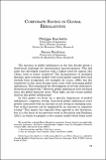Mostrar el registro sencillo del ítem
Corporate saving in global rebalancing
| dc.contributor.author | Bordo, Michael D. | |
| dc.contributor.author | Landon-Lane, John | |
| dc.date.accessioned | 2019-11-01T00:07:07Z | |
| dc.date.available | 2019-11-01T00:07:07Z | |
| dc.date.issued | 2015 | |
| dc.identifier.isbn | 978-956-7421-47-3 | |
| dc.identifier.uri | https://hdl.handle.net/20.500.12580/3894 | |
| dc.description | The increase in global imbalances in the last decade posed a theoretical challenge for international macroeconomics. Why did some less developed countries with a higher need for capital like China lend to richer countries? The inconsistency of standard dynamic open-economy models with actual global capital flows had already been recognized (for example by Lucas 1990) but the sensitivity to this issue became more acute with increasing global imbalances. This stimulated the development of several alternative theoretical frameworks. However global imbalances have declined since the global financial crisis. What light can the recent models shed on this global rebalancing? | |
| dc.format | ||
| dc.format.extent | Sección o Parte de un Documento | |
| dc.format.medium | p. 79-103 | |
| dc.language.iso | eng | |
| dc.publisher | Banco Central de Chile | |
| dc.relation.ispartof | Series on Central Banking Analysis and Economic Policies no. 20 | |
| dc.rights | Attribution-NonCommercial-NoDerivs 3.0 Chile | * |
| dc.rights.uri | http://creativecommons.org/licenses/by-nc-nd/3.0/cl/ | * |
| dc.subject | MACROECONOMÍA | es_ES |
| dc.subject | CRISIS FINANCIERA | es_ES |
| dc.subject | CRISIS ECONÓMICA 2008 | es_ES |
| dc.title | Corporate saving in global rebalancing | |
| dc.type.doc | Artículo | |
| dc.file.name | BCCh-sbc-v20-p079_103 |


